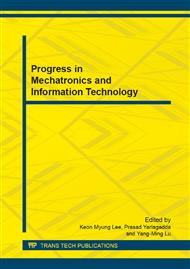p.712
p.716
p.720
p.727
p.735
p.739
p.746
p.750
p.755
Design of Dynamic Vision System for Modular Reconfigurable Robots
Abstract:
Modular reconfigurable robots (MRRS) is an approach to building robot for various complex tasks with the promise of great versatility, robustness and low cost. It can be used extensively to meet the demands of different tasks or different working environments by changing its shapes, such as from snake first to loop and next to quadruped, and so on. Therefore they can travel over or through obstacles, and go though small pipe. Even they can walk somewhat like a person on crutches. The quantity of the motion pattern will decide the adjustable ability of MRRS. So, dynamic vision system is very important for MRRS, which can improve its moving ability and intelligent degree. With the help of the dynamic vision system, the robot can accomplish different tasks in different working environments by itself, such as deciding routes and avoiding obstacles. In this paper, the dynamic vision system for MRRS will be analyzed and researched roundly, and three control approaches, such as open loop tracking, close loop servo and active vision system, are put forward.
Info:
Periodical:
Pages:
735-738
Citation:
Online since:
November 2013
Authors:
Price:
Сopyright:
© 2014 Trans Tech Publications Ltd. All Rights Reserved
Share:
Citation:


